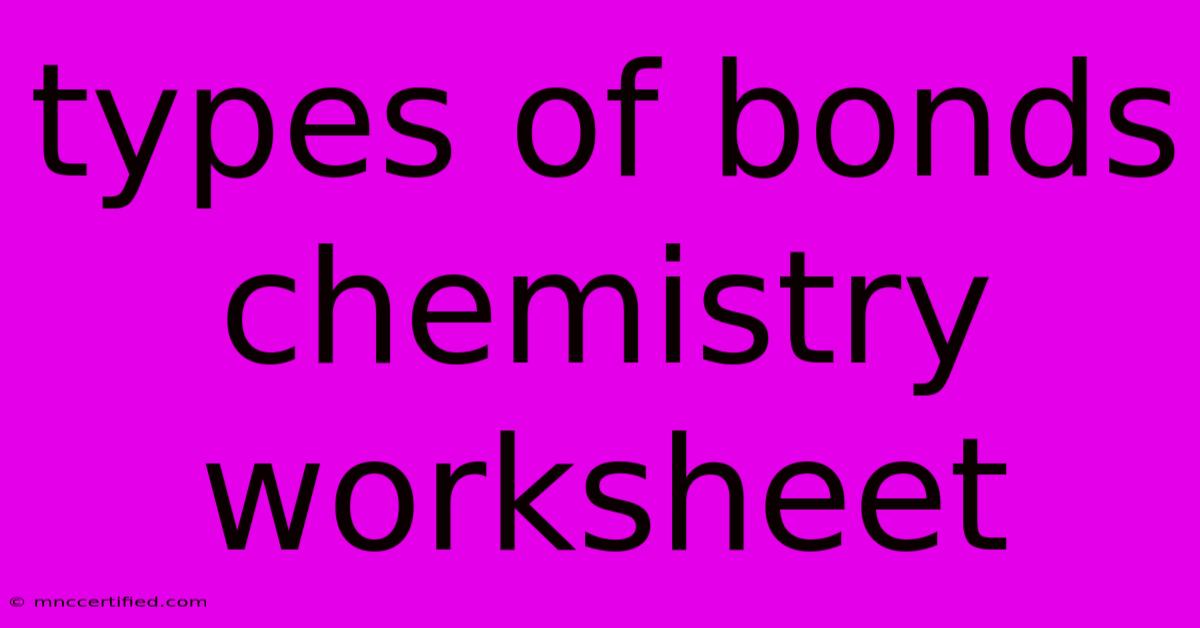Types Of Bonds Chemistry Worksheet

Table of Contents
Types of Bonds Chemistry Worksheet: A Comprehensive Guide
This article provides a comprehensive guide to understanding the different types of chemical bonds, perfect for supplementing your chemistry worksheet. We'll explore ionic, covalent, metallic, and hydrogen bonds, offering clear explanations and examples to enhance your comprehension. This guide is designed to help you master the concepts and ace your next chemistry test.
Understanding Chemical Bonds: The Basics
Chemical bonds are the forces that hold atoms together in molecules and compounds. These bonds arise from the electrostatic attraction between atoms, driven by the desire to achieve a stable electron configuration, often resembling that of a noble gas. Understanding the different types of bonds is crucial for comprehending the properties of matter.
1. Ionic Bonds: The Electrostatic Attraction
Ionic bonds form between atoms with significantly different electronegativities. Electronegativity refers to an atom's ability to attract electrons in a chemical bond. In an ionic bond, one atom (typically a metal) loses electrons to become a positively charged cation, while another atom (typically a nonmetal) gains these electrons to become a negatively charged anion. The electrostatic attraction between these oppositely charged ions forms the ionic bond.
Example: Sodium chloride (NaCl) – Sodium (Na) loses an electron to become Na+, and chlorine (Cl) gains an electron to become Cl-. The strong electrostatic attraction between Na+ and Cl- forms the ionic bond.
Key characteristics of ionic bonds:
- High melting and boiling points.
- Often soluble in water.
- Conduct electricity when dissolved in water or molten.
- Form crystalline structures.
2. Covalent Bonds: Sharing is Caring
Covalent bonds form when atoms share electrons to achieve a stable electron configuration. This typically occurs between nonmetal atoms with similar electronegativities. The shared electrons are attracted to the nuclei of both atoms, creating a bond.
Example: Water (H₂O) – Each hydrogen atom shares one electron with the oxygen atom, forming two covalent bonds.
Types of Covalent Bonds:
- Nonpolar Covalent Bonds: Electrons are shared equally between atoms with similar electronegativities. Example: Cl₂.
- Polar Covalent Bonds: Electrons are shared unequally between atoms with different electronegativities. One atom has a slightly negative charge (δ-), and the other has a slightly positive charge (δ+). Example: H₂O.
3. Metallic Bonds: A Sea of Electrons
Metallic bonds occur in metals. In this type of bond, valence electrons are delocalized, meaning they are not associated with any particular atom but are free to move throughout the metal structure. This "sea" of delocalized electrons creates strong metallic bonds.
Key characteristics of metallic bonds:
- High electrical and thermal conductivity.
- Malleability (can be hammered into sheets).
- Ductility (can be drawn into wires).
- Luster (shiny appearance).
4. Hydrogen Bonds: Special Interactions
Hydrogen bonds are a special type of intermolecular force (not a true chemical bond) that occurs between a hydrogen atom bonded to a highly electronegative atom (like oxygen, nitrogen, or fluorine) and another electronegative atom in a different molecule. These bonds are relatively weak compared to ionic or covalent bonds but are crucial in many biological systems.
Example: Water molecules (H₂O) – Hydrogen bonds form between the slightly positive hydrogen atom of one water molecule and the slightly negative oxygen atom of another water molecule.
Using this Information on Your Chemistry Worksheet
This information should help you complete any worksheet covering bond types. Remember to focus on:
- Identifying the atoms involved: This helps determine the type of bond likely to form.
- Considering electronegativity differences: Large differences suggest ionic bonds; small differences suggest covalent bonds.
- Recognizing the properties of the resulting compound: These properties often indicate the type of bond present.
By understanding these key concepts and applying them to your worksheet problems, you'll gain a firm grasp of chemical bonding. Remember to consult your textbook and class notes for further clarification and practice problems. Good luck!

Thank you for visiting our website wich cover about Types Of Bonds Chemistry Worksheet. We hope the information provided has been useful to you. Feel free to contact us if you have any questions or need further assistance. See you next time and dont miss to bookmark.
Featured Posts
-
Eva Longoria Speaks Out On U S Issues
Nov 15, 2024
-
Night Sky Guide Nov 15 22 Supermoon
Nov 15, 2024
-
Thursday Night Football Eagles Commanders
Nov 15, 2024
-
Taylor Swift Toronto Fans Gather Downtown
Nov 15, 2024
-
Mike Tyson Vs Jake Paul Uk Time And Stream
Nov 15, 2024